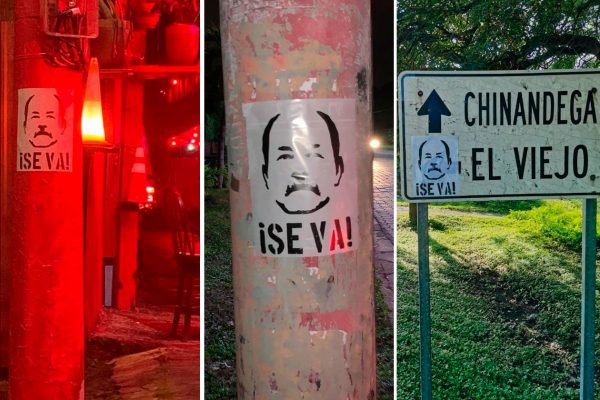Renewed Anti-Ortega Graffiti Reflects “Coordinated” Strategy

Sociologist Sergio Cabrales: Protest is a means of political change. The leadership should offer alternatives for a way out.
By Keyling T. Romero (Confidencial)
HAVANA TIMES – This week, the Civic Alliance organized “Operation Prisoner 198”. The initiative involved posting flyers opposing Daniel Ortega in 132 Nicaraguan municipalities.
The clandestine flyers bore a stencil of Ortega’s face with the legend “Se va!” [“He’s leaving!”]. The name “Operation Prisoner 198” refers to Ortega’s prison ID during his seven years in jail under the Somoza dictatorship.
This level of coordinated action hadn’t been seen in the country for a number of months. Sergio Cabrales, a sociologist and researcher, has studied Nicaraguan social protest over the past few years. In his view, this sudden break in the silence sends a strong message from opponents of the Ortega regime.
“It was interesting to observe this particular episode. It’s been a long time since there’s been a coordinated activity with an important number of participants. Some forms of political protests have persisted, but they didn’t convey this message of strength, numbers and coordination. It’s a very particular case,” said Cabrales. The sociologist who created the initiative “Nicaraguan Protest Observatory”, spoke during an interview with the internet news program Esta Noche.
After December 2019, the number of protests over political demands began dropping, due to the Ortega regime’s repression. The de facto police state that the regime imposed has been in effect since the last trimester of 2018. The protests that existed were largely concentrated in the capital. Nonetheless, demands have arisen on social, economic and environmental topics that have been tolerated by the authorities.
The key for the opposition is leadership
“I don’t mean to say that the protests are being displaced,” Cabrales explained. “However, other persons are appearing who protest for emergencies that always existed but were slightly pushed aside by the crisis.” In his judgement, this is an indication that the opposition groups don’t have a monopoly on the mobilizations. With the pandemic, some of the demands that had existed, such as freedom for the political prisoners, were modified. They became absorbed into the demand for prisoners’ freedom due to the danger of contagion within the prisons.
The state’s response, however, hasn’t changed. For example, although “Operation Prisoner 198” had a positive impact, in less than 24 hours four people had been arrested. All were accused of posting flyers opposing Ortega, according to denunciations of the Civic Alliance.
In the electoral context, Cabrales warned, it’s important for the opposition to find ways to grow both horizontally and vertically. That is, it must increase its organizational bases. There’s a large proportion of the population that opposes the regime but is still not organized. Any protest scenario will depend on this.
They also must work on leadership that can offer a way out to the population. The possibility of generating a critical scenario for the elections will depend on the leaders. The population is going to interpret what they say, and decide to join the mobilizations or not,” Cabrales explained.
On the other hand, the potential protests and the regime’s possible repression will also have a political cost. In the long run, it’s not sustainable. “They know how to measure their costs. They know that the next year is decisive.”
Protest as politics
In a democratic context, waves of protests don’t usually result in the creation of social movements. Nicaragua has been an exception to this, Cabrales noted. Here, the protests arose as a way to influence political decisions, since the institutional channels were closed or insufficient.
“In this case, protest can’t be considered an absolute, or the only way to generate change. However, it’s a way of expressing that people are betting on those changes. It’s also a way to making discontent visible,” Cabrales stated.
Protest, he maintained, must go hand in hand with organizing the opposition, formulating proposals, and building structures. During these processes, reconfiguration, like that occurring within the Civic Alliance, is necessary. This must happen even though these processes may generate apathy.
“New organizations, plus those existing prior to April, are betting on this tactic of configuring forces and organizing. This dimension is important, but the most visible dimension (the protests) weren’t being organized due to the authoritarian context. I feel it’s important to have a certain strategic balance. If protest isn’t being considered or organized, this can send a message contrary to your intentions,” Cabrales argued.
Cabrales has directed a study entitled: “Nicaragua in movement: analysis of the protests 2016-2020” He carried out the study in conjunction with the Nicaraguan Foundation for Economic and Social Development (Funides). The citizen protests will continue the study shows. They will occur if Daniel Ortega is reelected in 2021, or if the opposition wins through a democratic process. In the worst-case scenario, these could be equal in scope to the protests of 2018. At that time, the Ortega regime’s repression left 325 people dead between April and September. There were also thousands of wounded, dozens missing and over 100,000 exiles.






Ortega is a loser and the protests will continue